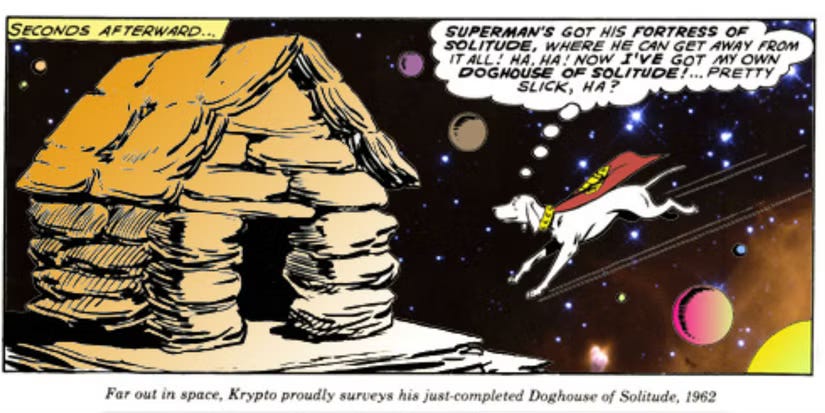Thursday Things is here! This week we pet radioactive dogs, regenerate our teeth, and join a team. Or maybe a group.
If you enjoy this edition, please click the heart icon in the header or at the end of the post to let me know.
Smile! Photo by Lesly Juarez on Unsplash
Dogs of Chernobyl
I’m going to warn you that this headline over promises:
Dogs living near Chernobyl nuclear disaster have mutated to develop new superpower
If you’re expecting Krypto the Superdog, sorry. No canine heat vision. Or flying. Or wearing capes.
Yes, there was a Doghouse of Solitude. Image: DC Comics via Screenrant
We last checked in on the dogs of Chernobyl in the April 2023 edition (Radioactive Rover), learning that stray dogs living in the radioactive exclusion zone around the Chernobyl plant showed distinct genetic differences from other dogs living a mere 1o miles away.
We also had an item about the Wolves of Chernobyl in February 2024. It seems the local wolves of the Chernobyl Exclusion Zone (CEZ) have developed genetic adaptations that make their cells resistant to radiation damage and cancer.
Your turn, Team Dog.
Our radioactive mutant canine friends will see your radiation resistance and raise:
Dogs living near the site of the Chernobyl nuclear disaster have mutated to develop a new superpower - they are immune to radiation, heavy metals and pollution.
As with with wolf population, the dogs have adapted to the toxic environment through prolonged exposure. And that helps not only the dogs, but potentially human beings as well.
You know, the species that caused this radioactive disaster zone in the first place.
Understanding how the dogs developed their genetic superpower could help better understand the health impacts of living in a highly toxic environment with multiple environmental hazards, not just in dogs but also in humans.
There are approximately 900 D-O-Gs of the CEZ, probably descended from dogs left behind when the area was evacuated after the Chernobyl nuclear accident in 1986.
The dogs developed genetic mutations passed down from generation to generation that have seemingly enhanced their survival in the harsh, contaminated conditions of the CEZ.
According to one of the scientists involved in the study: 'Examining the genetic and health impacts of these chronic exposures in the dogs will strengthen our broader understanding of how these types of environmental hazards can impact humans and how best to mitigate health risks.'
We’ll talk about the mutant Chernobyl tree frogs some other time.
Teeth regrown
I’m one of what I imagine is a small minority of people who enjoy going to the dentist. Mostly because my teeth are in good shape — brush and floss and avoid sugary drinks! — so I’m usually at the dentist for checkups and cleanings. Which is great! It’s like a spa day for your mouth!
I have an appointment today, in fact, which is why Thursday Things is going out earlier than usual.
But that’s me.
Many people have missing teeth, either due to age, accident, disease, decay, or other causes. And for the entirety of known history their only recourse has been to replace their missing teeth with dentures. Which involves all sorts of inconvenience and other issues.
This may soon change. I’ve been following research in Japan on a drug designed to regrow teeth. We had our last checkup in July 2023 (A story with bite) in which the drug had been successful in regrowing teeth in ferrets and mice, with human clinical trials expected to begin in the near future.
The near future is now: Clinical Trials For Drug That Replaces Missing Teeth Finally Underway
People with missing teeth may be able to grow new ones, say Japanese dentists testing a pioneering drug they hope will offer an alternative to dentures and implants.
Unlike reptiles and fish, which usually replace their fangs on a regular basis, it is widely accepted that humans and most other mammals only grow two sets of teeth.
But hidden underneath our gums are the dormant buds of a third generation, according to Katsu Takahashi, head of oral surgery at the Medical Research Institute Kitano Hospital in Osaka.
His team launched clinical trials at Kyoto University Hospital in October, administering an experimental medicine to adult test subjects that they say has the potential to jumpstart the growth of these concealed teeth.
The initial focus is to use the drug to treat people with a rare hereditary condition who are missing six or more permanent teeth from birth:
"This drug could be a game-changer for them," he added.
The drug is therefore aimed primarily at children, and the researchers want to make it available as early as 2030.
However, the current safety trial is giving the drug to adults who have lost at least one existing tooth.
And while tooth regeneration is not the express goal of the trial this time around, there is a slim chance that it could happen to subjects anyway, Takahashi said.
If so, the researchers will have confirmed that the drug can be effective for those with acquired toothlessness – which would be a medical triumph.
It would. Let’s hope the results give everyone something to smile about!
Groups vs Teams
J. Daniel Sawyer wrote a long and interesting post on his Substack about the difference between being part of a group and being part of a team — different dynamics, different mindsets, different roles for the members, and each grouping is best suited for different tasks.
Here’s the link:
I’ll give you a couple of excerpts to give the flavor, but if the topic interests you, read it all.
Of groups, Sawyer says “In a group, everyone is responsible for everyone else. The group needs to stay together, so you don’t just need to do head counts. You need to see to everyone else’s frame of mind. … There are threats to the group, and tensions within the group, but the group’s job is to do what the group is aiming to do and get everyone home safe.”
Also : “Any time humans work near one another, in a similar activity and without a strict division of labor, they function as a group.”
A team, on the other hand, functions quite differently from a group:
“A team pursues a common, directed goal—such as winning a baseball game, or producing a movie—and to achieve that goal they divide labor between themselves according to their strengths and expertise.
“Because of this, team roles are not fungible (i.e. they can’t be easily exchanged one for another).”
In nature, some animals function as groups — especially herd prey animals such as zebras, cattle and the like. But predators animals, like a pack of wolves or a pride of lions, operate as teams, cooperating in the hunt.
As for humans: “The ability of humans to do both cognitive modalities is an underappreciated superpower. This two-gear mentality is right up there with the opposable thumb as far as “great evolutionary tricks that put us at the top of the food chain”
We all find ourselves sometimes in a group, sometimes in a team. It’s important to recognize which type of environment you’re in, because each requires its own implicit way of thinking and interacting with fellow members.
Fascinating ideas. Much, much more at the link.
Thank you for reading!
Please click the hearts, leave a comment, and use the share feature to send this issue to a friend who might enjoy it. See you next Thursday!





